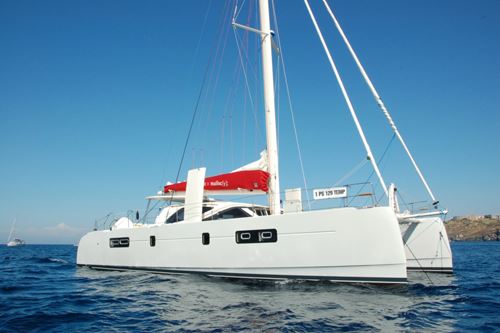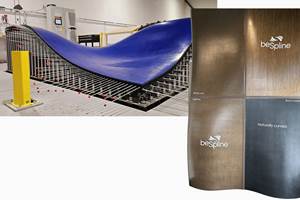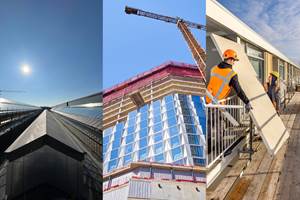New catamaran benefits from structural adhesives, vacuum infusion
Vacuum infusion, SAN sandwich foam cores and structural adhesives help reduce the weight of Mattia's high-performance catamaran yacht by 2,000 kg.
Luxury fiberglass catamaran boatbuilder Mattia (Lecco, Italy), recently launched the Mattia 60, an ocean-going sailing catamaran, designed to offer greater speed and maneuvrability. After extensive investigations into composite materials and processing options, the end result is a reengineered fiberglass craft, 19m/62 ft long by 9m/30 ft wide with a 23m/75.5 ft high mast. The boat displaces only 17,000 kg and is capable of sailing at up to 23 knots.
By using a combination of vacuum infusion for the composite hull and deck, high-performance SAN sandwich foam cores, plus using a structural adhesive to bond the hull bulkheads and to fix the deck to the hull, the weight of the catamaran was reduced by 2,000 kg/4,409 lb. With a new Mattia 60 retailing at around €1.5 million, the company says that only high-quality materials and the latest infusion technology have been used to achieve the exceptional build quality and long term performance.
To provide a high-quality, marine approved laminate construction for the hull and deck which Mattia was confident would provide reliable, long-term performance, Crystic VE679-03PA, a low-shrink, long gel time infusion grade resin was specified in combination with Crystic VE679PA skincoat behind a marine grade ISO/NPG gelcoat; the Crystic infusion resin and skincoat are both DCPD modified vinyl ester (VE) resins developed and manufactured by Scott Bader Company Ltd. (Northamptonshire, U.K.).
These DCPD-modified vinyl ester resins reportedly provide the additional benefit of an improved aesthetic finish due to reduced print-through. In critical performance areas of the superstructure which are subject to very high stresses and loads, such as the slamming area of the hull, sandwich laminate sections using Corecell M foam cores from SP-High Modulus (Isle of Wight, U.K.) were specified and formed part of the final infused hull and deck design.
At the design and construction phase, Mattia took advice from its supplier partners about the latest composite process technologies and techniques available to manufacture lighter and stronger large section fibreglass constructions. Resintex Technology (Frosinone, Italy), which specializes in closed mold technology and supplying composite raw materials and ancillaries to the Italian marine market, work in close collaboration with Richmond Aerovac Italy. They recommended vacuum bagging as the optimum infusion process to consistently and cost effectively produce high-quality, lighter-weight, high-performance very large composite parts, such as the 19m long hull and deck sections. Manufacturing by infusion provided the added major benefits of reducing overall labour costs by more than 25 percent and significantly improving shop floor health and safety conditions for the workforce; compared to open molding, styrene volatile organic compounds (VOC) emissions were reduced by more than 70 percent in both shipyards when they switched to vacuum bagging.
By designing the new Mattia 60 hull and deck around a vacuum bagging process Simonplast and Elvideo Giovanetti, the two Italian shipyard manufactures who produce the hulls and the decks for the Mattia 60, were able to make significant laminate performance and processing improvements compared with their traditional hand layup open-molding process. Infused parts were significantly lighter as less resin was used and more evenly distributed through the laminate. Tests carried out proved that better mechanical properties were achieved in the infused laminate and parts were able to be produced with a much greater consistency.
Simone Piscitelli, production director of Simonplast, said: “For such a large and complex vacuum bagging set up, when the infusion process is started, it is essential that the resin has a predictable, controllable and reliable long gel time whatever the time of year. We trust Crystic VE 679-03PA pre accelerated resin to perform as stated in the technical data sheet. We have been able to consistently produce high-quality vacuum infused hulls with an excellent laminate finish.”
To make further reductions in the overall weight of the catamaran, Mattia approved the use of Scott Bader’s Crystic Crestomer 1152PA, which has Lloyds Acceptance, DNV and RINA approvals for GRP marine bonding applications. By bonding in bulkheads instead of over laminating further significant reductions to the weight of the hull were achieved in the new design, while at the same time improving the overall mechanical performance of the hull construction; Crestomer 1152PA adhesive has a higher flexural modulus and ultimate tensile strength than the fiberglass laminate sections being bonded together. A significant reduction in production time was also achieved by bonding instead of over-laminating.
Related Content
Airbus video highlights RACER compound helicopter first flight
Launched as part of a Clean Sky 2 program, a compound design — rotor, split fixed-wing, propulsive propellers — uses composites to cut fuel consumption and emissions by 20%.
Read MoreComposite SIPs for more affordable, efficient and sustainable buildings
LiteSIP panels and modules enable framing in days, cutting structural labor and total cost by up to 70% and 30%, respectively, while increasing energy efficiency and durability.
Read MorePlant tour: BeSpline/Addcomp, Sherbrooke, QC, Canada
Composites automation specialist increases access to next-gen technologies, including novel AFP systems and unique 3D parts using adaptive molds.
Read MoreBio-based, fire-resistant composites become mainstream
Projects use Duplicor prepreg panels with highest Euroclass B fire performance without fire retardants for reduced weight, CO2 footprint in sustainable yet affordable roofs, high-rise façades and modular housing.
Read MoreRead Next
Plant tour: Daher Shap’in TechCenter and composites production plant, Saint-Aignan-de-Grandlieu, France
Co-located R&D and production advance OOA thermosets, thermoplastics, welding, recycling and digital technologies for faster processing and certification of lighter, more sustainable composites.
Read More“Structured air” TPS safeguards composite structures
Powered by an 85% air/15% pure polyimide aerogel, Blueshift’s novel material system protects structures during transient thermal events from -200°C to beyond 2400°C for rockets, battery boxes and more.
Read MoreAll-recycled, needle-punched nonwoven CFRP slashes carbon footprint of Formula 2 seat
Dallara and Tenowo collaborate to produce a race-ready Formula 2 seat using recycled carbon fiber, reducing CO2 emissions by 97.5% compared to virgin materials.
Read More

%20Mattia%2060%20catamaran%20vaccum%20infusion%20of%20hull%20section%20low%20res%20version_web.jpg;width=860)
%20Mattia%2060%20catamaran%20vacuum%20infusion%20of%20hull%20section%20low%20res%20version_web.jpg;width=860)





















